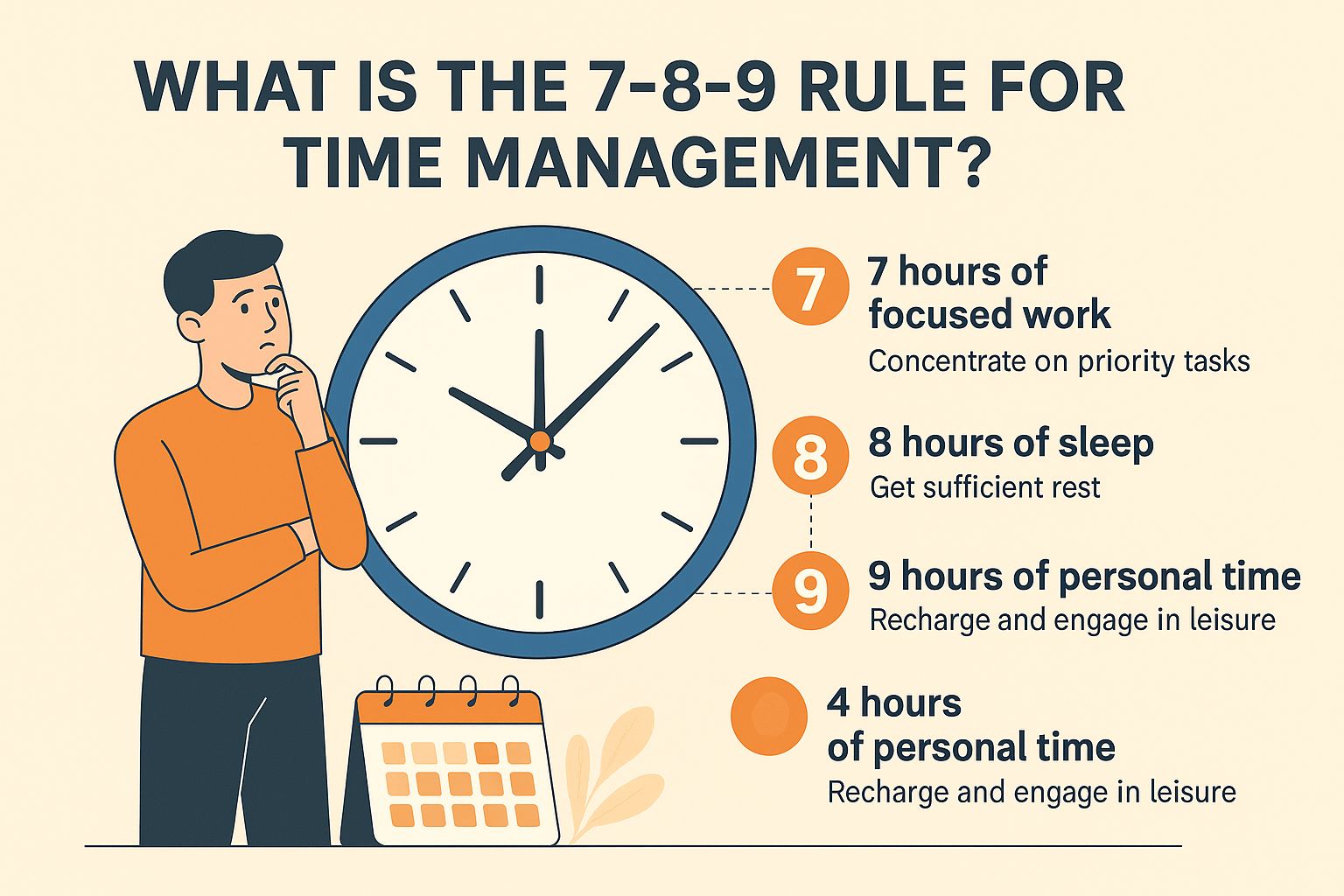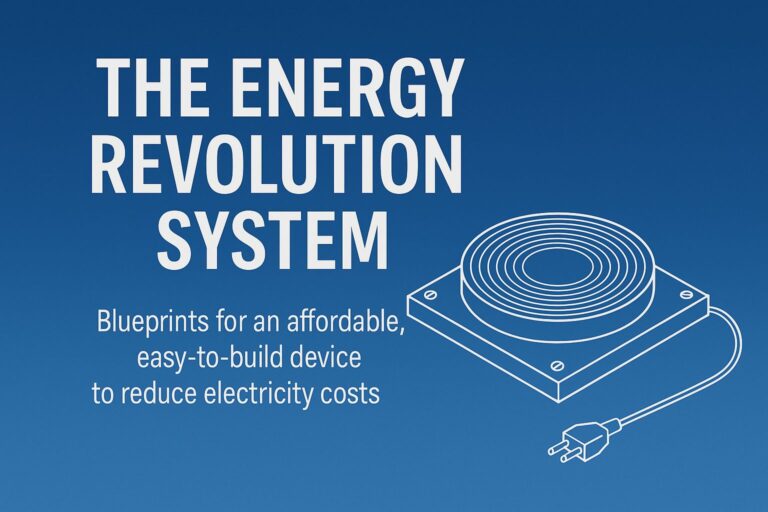
The 7-8-9 rule is a simple way to balance a 24-hour day: split it into fixed blocks for sleep, focused work, and everything else (life admin, family, hobbies, meals, commuting). Most commonly it’s framed as 7 hours for productive work, 8 hours for sleep, and 9 hours for personal/life time—a rhythm meant to keep output high without burning you out.
Because it’s a folk rule rather than a standard, you’ll see variants: some people flip the numbers (e.g., 7–8 hours sleep, 8–9 hours work, ≥7 hours personal time), while others use it as a morning cue (wake by 7, start by 8, knock out the top priority by 9). The spirit stays the same: build guardrails that protect rest, concentrate work, and leave real time for life.
Why it works
- Hard caps beat fuzzy intentions. Fixed buckets stop work from swallowing the day and force trade-offs you can see.
- Energy alignment. Protecting sleep and concentrated blocks generally improves attention and mood, which cycles back into better work.
- Easy to remember. No app required—just three numbers.
The rule also lowers decision fatigue. Instead of renegotiating your day every hour, you operate inside a known frame: this is work time, that is life time, and sleep is non-negotiable. When the buckets are pre-allocated, you spend less mental energy on whether you “should” keep working and more on doing the work that matters.
It encourages sustainable pacing. By defaulting to seven truly focused hours instead of a performative nine or ten, you create pressure to prioritize, batch, and say no. Quality rises when you assume scarcity, and your “9” bucket gives you recovery time so tomorrow’s seven hours are actually sharp.
A sample “classic” 7-8-9 day
- Sleep (8h): 22:30–06:30
- Work (7h): 08:30–12:00; 13:30–17:00 (includes a real lunch + two short breaks)
- Life (9h): 06:30–08:30 & 12:00–13:30 & 17:00–22:30 (family, exercise, chores, hobbies, commute)
Swap the numbers if your job needs 8–9 hours most days—just preserve a non-negotiable sleep window and a real personal block.
How to implement it (in 5 steps)
- Pick your version (7-8-9 or a flipped variant) and write the three daily caps.
- Time-box work into 60–120-minute focus blocks with breaks; park meetings in the afternoon where possible.
- Budget the “9”: pre-assign slots for meals, movement, family, and one restorative hobby.
- Guard sleep: set a fixed get-ready-for-bed alarm 45 minutes before lights-out.
- Audit weekly: if one bucket keeps overflowing, resize deliberately (e.g., bump work to 8 and trim life to 8.5) instead of letting it creep.
Treat the first two weeks as a calibration sprint. Track where time actually goes, compare it to your intended buckets, and adjust the start/stop rituals that anchor each block (coffee + headphones to start work; walk + phone on Do Not Disturb to end it).
Give each bucket a visual boundary. Place your work devices out of sight during the “9,” dim the home lights 45 minutes before bed, and use a single-page daily planner with three columns labeled 7 / 8 / 9 so the day’s plan mirrors the rule at a glance.
Tips & adjustments
- Shift workers/parents/students: use the numbers as averages over a week, not rigid daily quotas.
- High-demand seasons: make a temporary exception window (e.g., launch week = 9 hours work) with a scheduled return to baseline.
- Morning-momentum variant: try the “7-8-9 morning cue”—up at 7, focused by 8, hardest task done by 9—to front-load wins even if the rest of the day is chaotic.
Don’t let the “7” become seven hours of reactive tasks. Reserve at least one Prime Block (90–120 minutes) daily for your single most leveraged activity. Push email, chat, and small rocks into one late-afternoon batch to protect deep work.
Use bucket buffers. Add a 10–15 minute “handoff” ritual between work and life (quick tidy, short walk, or journaling). This tiny decompression keeps the “7” from bleeding into the “9,” and it prevents decision carryover from hijacking your evening.
Pros and cons
Pros
- Clear, memorable structure that encourages work-life boundaries.
- Forces sleep hygiene into the plan.
- Plays well with other systems (Pomodoro, weekly reviews, Eisenhower/Covey).
Cons
- Not one-size-fits-all; caregivers and shift workers may need flexible averages.
- Creative or deep-work roles might prefer fewer but longer work blocks.
- If treated as dogma, it can create guilt instead of guidance.
7-8-9 vs other frameworks
- 8-8-8 (work/sleep/life in equal thirds) is a cousin that’s easier to remember but less forgiving if your job rarely fits an 8-hour cap.
- “Balance first” takes swap which number belongs to which bucket; the takeaway across approaches is the same balancing act.
Compared with Pomodoro, which optimizes minute-level focus, 7-8-9 is a macro framework. You can still run Pomodoros inside the “7,” but the rule gives you the big boundaries that Pomodoro alone doesn’t address (sleep and life protection).
Versus time-blocking or calendar budgeting, 7-8-9 is simpler and more flexible. It’s ideal if full-day micro-planning feels heavy; you get just enough structure to prevent drift without turning your schedule into a spreadsheet sport.
Bottom line
The 7-8-9 rule isn’t a stopwatch—it’s a guardrail. Choose the variant that suits your season of life, enforce genuine boundaries around sleep and work, and budget the “9” for the people and practices that keep you human. Review weekly, adjust consciously, and let the numbers help you live on purpose, not on autopilot.Used thoughtfully, it becomes a conversation starter—with yourself, your team, and your family—about trade-offs. You’ll quickly see where time leaks happen, what truly moves the needle, and which commitments deserve a yes. Keep it light, iterate monthly, and let the rule serve you, not the other way around.


